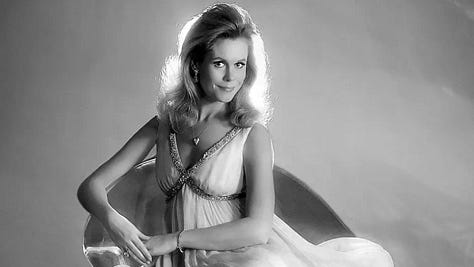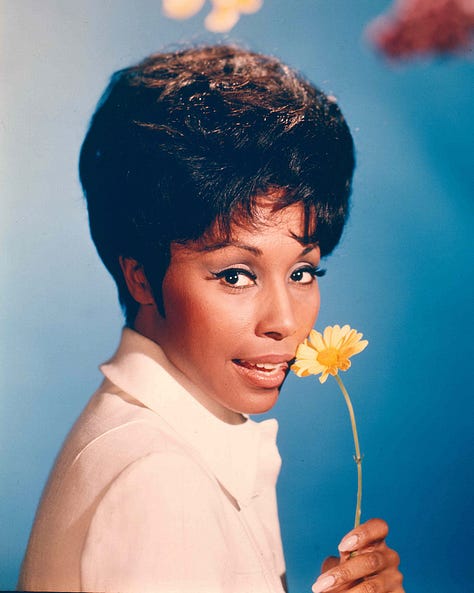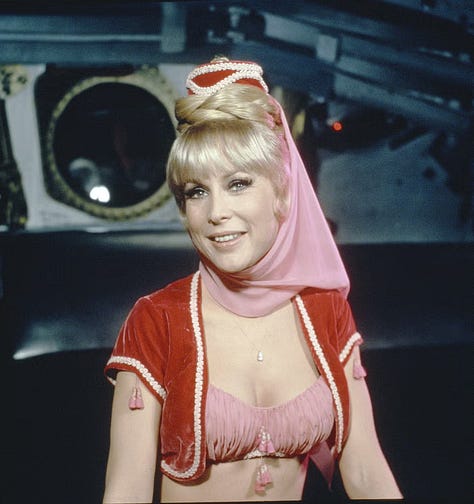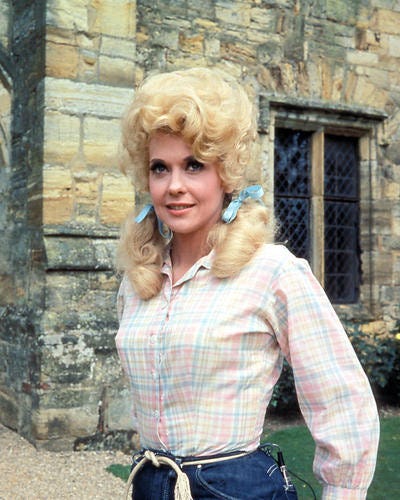


Picture this: it's 1968, and families are gathered around their TVs. Suddenly, Diahann Carroll appears as Julia Baker – a widowed nurse, a single mom, and groundbreakingly, the first Black woman to star in her own sitcom without playing a maid. She’s dressed impeccably, radiating confidence and a quiet strength that challenged everything people thought they knew. "Julia" became a weekly ritual for 24 million viewers, proving that glamour wasn't just about looking pretty; it could be a powerful statement. These women – Diahann Carroll, Mary Tyler Moore, Elizabeth Montgomery, Barbara Eden, Eva Gabor, and so many others – weren't just decorating our screens; they were defining an era, blending allure with ambition in a medium that was exploding across America.
The 1950s were television's awkward teenage years, fresh out of its radio phase. By the mid-50s, half of American homes had a TV, and by 1960, a whopping 90% did! This was the golden age of sitcoms and variety shows, and the "glamour girl" was queen. But unlike the untouchable movie stars – think Marilyn Monroe's bombshell allure or Audrey Hepburn's elegant sophistication – TV actresses were like friends popping over for a nightly visit. Their glamour felt attainable, a promise that beauty could fit right into your living room, right alongside the family. Eva Gabor, with that fabulous Hungarian accent and her over-the-top wardrobe, turned "Green Acres" into a weekly fashion show. And Barbara Eden? She sparked a national craze with those pink harem pants in "I Dream of Jeannie." These women weren't just characters; they were icons in a postwar America obsessed with looking good and feeling good.
But let's be real: that glamour didn't just *happen*. It was carefully crafted by the studios. Networks like NBC and CBS, flush with cash from cosmetics and car companies, meticulously molded their stars. Take Mary Tyler Moore. She started as a leggy receptionist in "Richard Diamond, Private Detective," but by 1961, she was transformed into Laura Petrie on "The Dick Van Dyke Show." Those capri pants and that iconic flipped bob? They were designed to strike a perfect balance between sex appeal and suburban relatability, and they became a uniform for millions of women. Behind the scenes, these actresses were working incredibly hard. Elizabeth Montgomery, the bewitching Samantha Stephens, joked that the producers would have her wiggle her nose to fix a bad script if they could! She had this ethereal beauty, sure, but she also had a sharp wit and a contract that demanded she be effortlessly charming, even while juggling crazy-long workdays and a personal life that wasn't always so charmed.
For some, glamour was a way to sneak in some serious messages. Diahann Carroll's "Julia" wasn't just a hit show; it was a cultural earthquake. Before her, Black women on TV were mostly playing maids or stereotypical "mammy" roles – think of Hattie McDaniel in "Beulah." Carroll, who had already won a Tony on Broadway, insisted on playing a sophisticated woman. As she put it, "I wanted to be the first Black woman on television who had a job, a child, and a life." Her wardrobe, full of tailored dresses and elegant coats, reflected her character's dignity and stood in stark contrast to the racial tensions of the time. Some critics called her "a Negro Mary Tyler Moore," but Carroll's success was unique, paving the way for so many future stars. In her hands, glamour became a tool for empowerment, not just decoration.
The 1960s brought color TV and a whole lot of social change, which only amplified these women's appeal. "I Dream of Jeannie," which premiered in 1965, dove headfirst into fantasy with Barbara Eden's sparkling costume and playful flirtations, drawing in 20 million viewers at its peak. But even Jeannie wasn't immune to the era's sensitivities. Eden famously fought with NBC execs who thought her navel was too scandalous! She won that battle, solidifying her status as a sex symbol who was also in control. Meanwhile, Eva Gabor's Lisa Douglas on "Green Acres" used glamour for laughs, hilariously clashing her Fifth Avenue lifestyle with rural absurdity. These roles reflected a society grappling with tradition and change – women could be glamorous, funny, flawed, and fiercely independent. As the decade wore on, the Vietnam War and the Civil Rights Movement played out alongside these shows, hinting at a world that their glossy surfaces couldn't quite hide.
Fashion was their megaphone. Costume designers like William Travilla and Bob Mackie turned these actresses into trendsetters. Mary Tyler Moore's Laura Petrie popularized that casual-chic look, while Elizabeth Montgomery's Samantha Stephens mixed mod miniskirts with witchy capes, inspiring Halloween costumes for generations. And Barbara Eden's genie outfit, hand-stitched with ten yards of chiffon, spawned knockoffs that you could buy at Sears! Fan magazines like *Photoplay* couldn't get enough, with headlines like "Steal Eva Gabor's Glamour Secrets!" Readers would even mail in sketches of their own outfits, desperate to copy the look. Off-screen, these women had to walk a tightrope. Eva Gabor threw lavish Hollywood parties in silk gowns, while Mary Tyler Moore tried to dodge the paparazzi in sunglasses and scarves. Their glamour had to be both perfect and relatable, a tricky balance that fueled their fame and their struggles.
But glamour had its downsides. Studios enforced strict beauty standards – tiny waists, teased hair, and picture-perfect smiles. Actresses like Donna Douglas, who played Elly May Clampett on "The Beverly Hillbillies," were often typecast as ditzy blondes, their real intelligence hidden behind a country accent. Contracts could dictate everything from diets to hairstyles to dating lives. Elizabeth Montgomery, a liberal activist who later became a vocal supporter of gay rights, chafed under the fluffy premise of "Bewitched," once saying, "I'd rather be marching than twitching!" The pressure to stay young and beautiful was constant. By the late '60s, when Mary Tyler Moore was transitioning to "The Mary Tyler Moore Show," some people whispered that she was "too old" at 33 to play a single, career-driven woman. Glamour, for all its sparkle, could be a gilded cage.
Still, audiences couldn't get enough. Ratings soared – "Bewitched" topped the charts with 25 million viewers in 1966, and "I Dream of Jeannie" wasn't far behind. Fan clubs popped up, and the stars were flooded with letters. One teenager wrote to Barbara Eden, "You make me believe I can do anything," a sentiment that was echoed in homes across the country. These women offered an escape – Samantha's magic could fix anything, and Jeannie's bottle promised wish fulfillment. But they also reflected their viewers' own dreams. Mary Tyler Moore's Laura was a housewife with a sharp wit, and Diahann Carroll's Julia was a mother with real strength. In an era when the women's liberation movement was just beginning to gain momentum, these glamour girls hinted at possibilities beyond the kitchen, even if their scripts didn't always say it outright.
Their male co-stars – Dick Van Dyke, Larry Hagman, Eddie Albert – were supporting players, not rivals. The glamour girls owned the screen, and their charisma drove the stories. But unlike movie stars, who maintained their mystique by staying at a distance, TV actresses thrived on familiarity. As Mary Tyler Moore wrote in her memoir, "We were in people's homes every week. They felt like they knew us." This intimacy created loyalty, but it also meant more scrutiny. The tabloids jumped on Barbara Eden's divorce and Elizabeth Montgomery's affairs. Their glamour had to be both perfect and relatable, a paradox that fueled both their stardom and their struggles. Film offered Oscars; TV offered ubiquity, and these women seized it, turning those 22-inch screens into their own kingdoms.
Their legacy lives on. Mary Tyler Moore's reinvention in the 1970s as Mary Richards, a single, career-driven producer, inspired Tina Fey and Amy Poehler, who have called her a pioneer. Diahann Carroll's barrier-breaking role echoes in Zendaya's powerful performances. Barbara Eden's Jeannie still shows up in Halloween costumes, and Elizabeth Montgomery's Samantha is all over TikTok. Their style – those capri pants, those harem pants – keeps coming back in fashion magazines. But their real triumph was their resilience. They navigated an industry that objectified them, stretched their talents to the limit, and yet they still managed to leave a lasting mark. Critics might have dismissed them as fluff, but history has proven them wrong.
Looking back, the glamour girls of the 1950s and 1960s were so much more than just sequins and smiles. They were products of a postwar boom, sure, but they were also harbingers of change. Diahann Carroll challenged racism, Mary Tyler Moore redefined womanhood, and Elizabeth Montgomery poked fun at conformity – all while looking fabulous. Their glamour wasn't just skin-deep; it was a language of power, a way to command attention in a male-dominated world. But it also held them back, a double-edged sword that they wielded with grace. As television has evolved into a grittier, more cynical medium, their era might seem quaint – black-and-white fading to color, innocence giving way to irony. But watch an old episode of "Bewitched" or "Julia," and their magic still works. It's a reminder that glamour, at its best, isn't just about looking good; it's about having the courage to be yourself.
And today, we see their influence in every empowered woman on TV, from Peggy Olson in "Mad Men" to Rue in "Euphoria." The small screen that they conquered remains a battleground for representation and identity, and their victories laid the foundation. So, let's raise a glass – or maybe just twitch our noses – to the glamour girls who turned television into both a mirror and a dream, proving that beauty, when used wisely, can rewrite the script of an era. They didn't just light up our screens; they lit the way forward.


